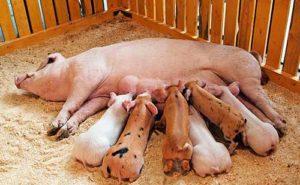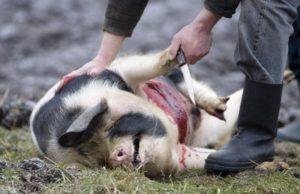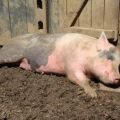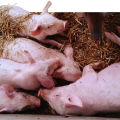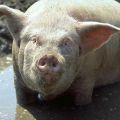The causative agent of pig tsum, its symptoms and treatment, is it dangerous for humans
Swine fever is a dangerous infectious disease, due to which animals can develop other more dangerous diseases. For example, they may develop pneumonia, hemorrhagic diathesis, or croupous intestinal inflammation. Before you try to cure the plague, you need to familiarize yourself in more detail with the features of this disease.
Description of the disease
Every person who is going to raise pigs in the future should familiarize themselves with the description of plague in pigs. This infectious disease rarely occurs in piglets. However, if the animals are already sick, then it will be difficult to cure them due to the resistance of the plague to drug treatment. The disease is very dangerous, since individuals of any age can get sick with it. Even adult piglets with strong immune systems are not immune to plague. For the first time, the disease was detected in Africa. However, over time, it spread to other continents. Now the plague can be infected by animals in any country.
How is it transmitted?
It is necessary to understand in advance the peculiarities of the transmission of this dangerous infectious disease. Animals can contract the plague after contact with already infected piglets. In addition, the causative agent of the disease is found in water, food, and even on the surface of inventory. The penetration of the virus into the body is facilitated by damage to the surface of the skin and even bites left by insects.
Most of the animals that contract the plague die. However, individuals who managed to survive remain carriers of the virus.
All pigs living within a radius of ten kilometers are at risk of infection. Therefore, immediately after the first symptoms of the disease appear, the infected animals are isolated from the rest of the piglets.
CSF symptoms
Symptoms directly depend on the type of disease.

Intestinal form
Many piglets become infected with intestinal disease, due to which the animal's digestive processes are disrupted. The first signs of distemper do not appear immediately, but several days after infection. Therefore, farmers are not always able to immediately determine what the mumps is sick with.
At first, animals begin to develop constipation. Problems with bowel movements continue for several weeks. In the intervals between constipation, gilts develop diarrhea. Then, other signs of the virus gradually appear, which include fever and enterocolitis. A sick piglet stops eating, which leads to weight loss.If left untreated, the infected animal will die.
Pulmonary form
This type of distemper is considered one of the most dangerous, as it often leads to the death of a sick animal. At first, the distemper does not manifest itself in any way, and therefore it is difficult to determine that the pig is sick with something. However, over time, the first symptoms begin to appear, which should be addressed.
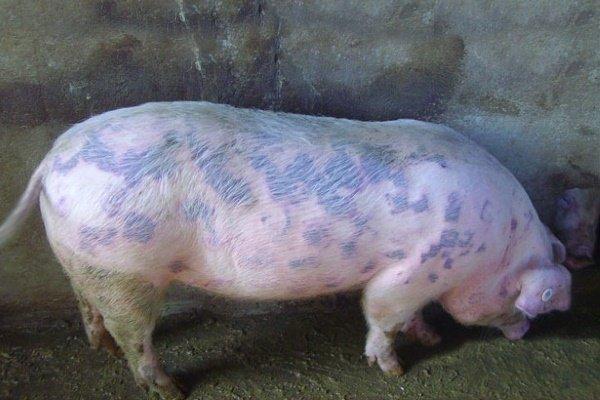
The initial signs of pneumonic plague include the following:
- cough that gradually gets worse;
- pneumonia, accompanied by an increase in body temperature;
- discharge from the nose of mucous fluid;
- shortness of breath with snoring.
Also, animals that get sick with plague often begin to sit on their hind legs. They do this to relieve pain in the lungs.
Chronic form
Sometimes sick animals do not die from the disease, but remain alive. In this case, the distemper becomes chronic. Symptoms appear from time to time. Piglets periodically suffer from fever, pneumonia and severe coughing. Sometimes sick pigs have symptoms characteristic of an atypical virus. These features include the following:
- weight reduction, due to which the animal practically does not have a fat layer;
- fever due to increased body temperature;
- loss of appetite;
- conjunctivitis;
- difficulty breathing.
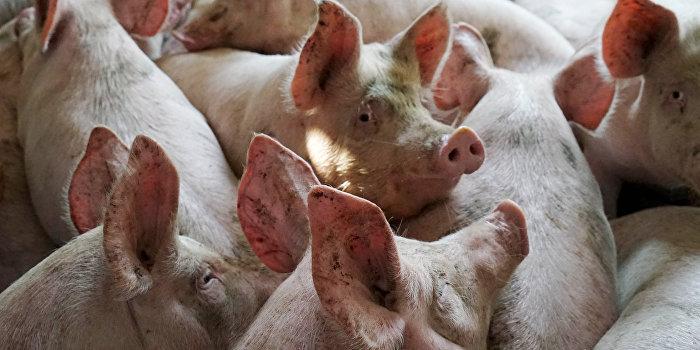
Acute form
According to many farmers, the acute form is considered the most dangerous, since due to the rapid development of the disease, animals die within 5-10 days. It is not easy to determine the disease in a timely manner due to the fact that it does not manifest itself immediately. In the early days, the disease does not manifest itself in any way. However, then the following symptoms appear abruptly:
- fever and fever;
- diarrhea, during which feces come out with red streaks of blood;
- nasal congestion;
- redness of the eyes;
- the appearance of yellow pustules in the ears and abdomen;
- minor subcutaneous hemorrhages.
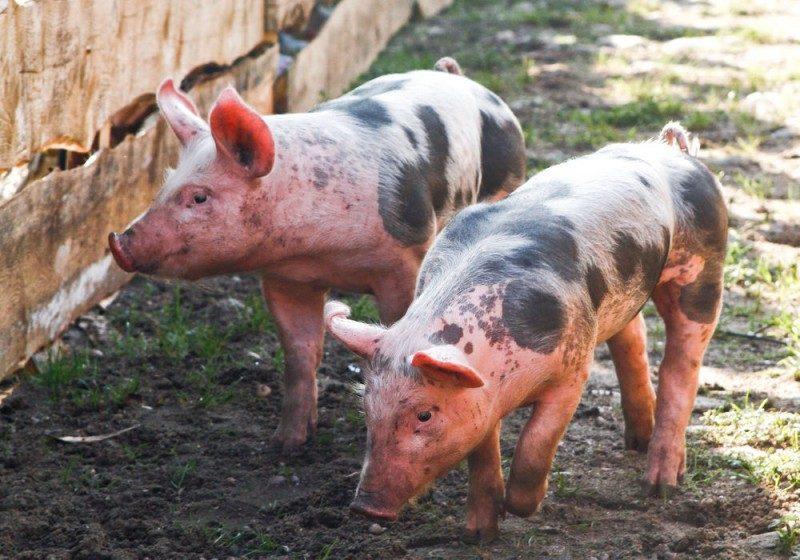
Lightning shape
People who are raising small pigs should be wary of the fulminant type of virus. This disease most often occurs in piglets that are less than six months old. The lightning-fast form is dangerous for the weakened organism of animals. They can die within a few days of symptoms.
Common signs of fulminant plague include:
- Vomiting. This is the main symptom that manifests itself much earlier than others.
- Spots under the skin. They appear as a result of subcutaneous bleeding due to vascular damage.
- Temperature increase. Due to inflammatory processes in the body, the body temperature rises greatly.
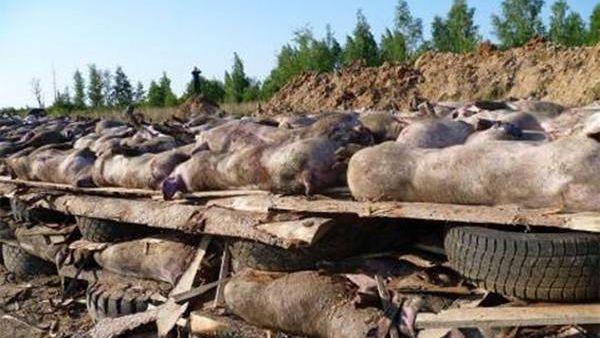
Subacid form
Some animals have conditional resistance to this virus and therefore rarely become infected with other types of virus. Most often, these pigs suffer from the subacid type of the disease, which is characterized by symptoms of the pulmonary and intestinal forms.
The duration of the illness is two and a half weeks. After this, the subacid plague can become chronic. If this does not happen, the animal will die due to complications. The most common complication is salmonellosis, which impairs bowel function. Animals develop diarrhea with a discharge of pus and blood. Piglets also stop eating, which leads to rapid weight loss.
Diagnosis of the disease
Some farmers believe that you can diagnose plague yourself. However, this is not easy to do, and therefore, to establish an accurate diagnosis, it is necessary to carry out special laboratory tests. Most often, during the diagnosis process, a blood sample is taken and tests are performed.In this case, blood must be taken from animals that are sick for a long time or have been in contact with piglets infected with the distemper virus.

Sometimes the diagnosis is confirmed by examining the spleen particles. However, this is done in extreme cases, when a blood test did not help determine the disease.
Treatment of classic swine fever
Despite the fact that plague is considered an old disease, no effective cure has yet been developed against it. Therefore, if it becomes known that the piglet is ill with this ailment, it is immediately isolated from other animals. Emergency vaccinations are also available, which sometimes save the lives of already infected piglets.
If the vaccination fails, then the livestock will have to be destroyed and their corpses burned. This will prevent the spread of the disease.
Is swine plague dangerous for humans
Many farmers who plan to breed piglets are interested in whether plague is dangerous to humans. You can relax, as this disease does not pose a danger to people. Not a single case has been recorded that a person contracted the plague from a piglet. The meat of sick animals can even be eaten. However, before that, it is subjected to heat treatment for a long time. It is thoroughly fried or boiled in boiling water for several hours. Smoking such meat is contraindicated, since smoking does not destroy the distemper pathogens.
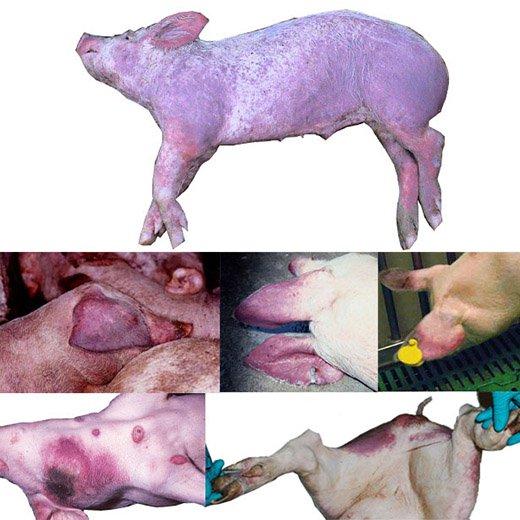
Disease prevention
The following preventive measures are distinguished, thanks to which they protect piglets from plague:
- maintaining order inside the pigsty and in areas for walking animals;
- regular disinfection of the premises;
- disinfection of drinking water for pigs and heat treatment of feed;
- vaccination against plague;
- fencing the pigsty with a fence so that foreign animals do not enter its territory;
- organization of a separate place for bathing animals in the pigsty.
The prevalence of CSF in Russia and in the world
The disease is rare on the territory of the Russian Federation, since most of the piglets must be given special vaccinations. Most of the infected pigs were in 2010-2013. During this period, more than a million pigs were killed. Most often, distemper occurs in African countries, in which pigs are vaccinated much less frequently.
Conclusion
Some farmers face plague when raising piglets. Therefore, before breeding such animals, it is necessary to familiarize yourself with the description of such a virus, its symptoms and methods of prevention. This will help protect animals from plague infection.
